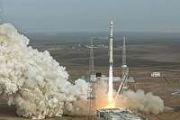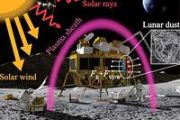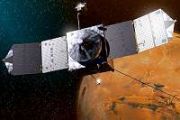
Copernical Team
Ever wonder why some meteor showers are so unpredictable
 A newly published study by SETI Institute researchers suggests that the irregularity of certain meteor showers arises not from chaotic planetary influences but from the subtle, yet consequential, motion of the Sun itself. The findings, presented in the journal Icarus, offer a fresh perspective on the long-term behavior of comets and their meteoroid trails.
"Contrary to popular conception,
A newly published study by SETI Institute researchers suggests that the irregularity of certain meteor showers arises not from chaotic planetary influences but from the subtle, yet consequential, motion of the Sun itself. The findings, presented in the journal Icarus, offer a fresh perspective on the long-term behavior of comets and their meteoroid trails.
"Contrary to popular conception, Crystal record reveals ancient wet phases on Mars
 A research team led by Queensland University of Technology (QUT) has revealed new insights into Mars' geological and hydrological past by analyzing crystal structures in minerals identified by NASA's Perseverance rover. Their findings provide strong evidence for repeated episodes of mineral formation under varying environmental conditions just beneath the Martian surface.
The study, led by
A research team led by Queensland University of Technology (QUT) has revealed new insights into Mars' geological and hydrological past by analyzing crystal structures in minerals identified by NASA's Perseverance rover. Their findings provide strong evidence for repeated episodes of mineral formation under varying environmental conditions just beneath the Martian surface.
The study, led by Sols 4511-4512: Low energy after a big weekend
 Earth planning date: Monday, April 14, 2025: We all know the feeling-it's Monday morning after a packed weekend, and you wish for just a bit more time to rest. Curiosity is likely feeling the same today.
Over the weekend, the rover completed a full slate of activities, including contact science, a MAHLI stereo imaging test, simultaneous ChemCam passive spectral data collection and orbiter
Earth planning date: Monday, April 14, 2025: We all know the feeling-it's Monday morning after a packed weekend, and you wish for just a bit more time to rest. Curiosity is likely feeling the same today.
Over the weekend, the rover completed a full slate of activities, including contact science, a MAHLI stereo imaging test, simultaneous ChemCam passive spectral data collection and orbiter China deploys three-satellite system in Earth-Moon retrograde orbit
 China has successfully established the first three-satellite constellation operating in the distant retrograde orbit (DRO) of the Earth-Moon system, a major achievement in the nation's ongoing expansion of deep-space infrastructure, researchers announced during a recent symposium in Beijing.
The trio now orbiting in DRO comprises two spacecraft, DRO-A and DRO-B, launched in March last year
China has successfully established the first three-satellite constellation operating in the distant retrograde orbit (DRO) of the Earth-Moon system, a major achievement in the nation's ongoing expansion of deep-space infrastructure, researchers announced during a recent symposium in Beijing.
The trio now orbiting in DRO comprises two spacecraft, DRO-A and DRO-B, launched in March last year Astronomers detect exoplanet on rare perpendicular path around binary brown dwarfs
 Astronomers have identified an unusual exoplanet, 2M1510 (AB) b, which travels on a polar orbit around a unique pair of brown dwarfs. This marks the first confirmed case of a planet circling two stars at a 90-degree angle relative to their orbit, offering fresh insights into planetary dynamics in binary systems.
The host objects, both classified as brown dwarfs, lie in a rare category of s
Astronomers have identified an unusual exoplanet, 2M1510 (AB) b, which travels on a polar orbit around a unique pair of brown dwarfs. This marks the first confirmed case of a planet circling two stars at a 90-degree angle relative to their orbit, offering fresh insights into planetary dynamics in binary systems.
The host objects, both classified as brown dwarfs, lie in a rare category of s China to launch new crewed mission into space this week
 China is expected to launch a new crewed mission into space this week, as Beijing takes steady steps towards its goal of putting astronauts on the Moon.
The Shenzhou-20 mission will blast off from the Jiuquan Satellite Launch Center in northwestern China, carrying three astronauts to the country's self-built Tiangong space station for a likely six-month stay.
The team will undertake expe
China is expected to launch a new crewed mission into space this week, as Beijing takes steady steps towards its goal of putting astronauts on the Moon.
The Shenzhou-20 mission will blast off from the Jiuquan Satellite Launch Center in northwestern China, carrying three astronauts to the country's self-built Tiangong space station for a likely six-month stay.
The team will undertake expe ESA welcomes inauguration of the African Space Agency

The European Space Agency has joined the world space community in congratulating the African Space Agency on its official inauguration. The African Space Agency (AfSA) is the second regional space agency after ESA and has been in development since 2015, with the African Union Commission adopting an African space policy and strategy in 2016.
ACES on its way to space
 Image:
Image:
Today at 10:15 CEST, ESA’s Atomic Clock Ensemble in Space (ACES) began its journey to the International Space Station on a SpaceX Falcon 9 rocket launched from NASA’s Kennedy Space Center in Florida, United States.
ACES carries the most accurate clocks ever flown in space – PHARAO and the Space Hydrogen Maser – designed to keep time so precisely that they would lose just one second every 300 million years. Developed by the French space agency CNES and Safran Timing Technologies in Switzerland, these European-built clocks will work with a sophisticated time transfer time using microwave and laser links to
Surviving lunar night with radioisotope energy
 At the 40th Space Symposium, ispace technologies U.S., inc. (ispace-U.S.) and Zeno Power Systems, Inc. (Zeno Power) announced a joint initiative to develop power systems that enable sustained operations during the Moon's prolonged periods of darkness. The strategic agreement sets the stage for a demonstration mission as early as 2027.
Surviving the lunar night has been identified by NASA a
At the 40th Space Symposium, ispace technologies U.S., inc. (ispace-U.S.) and Zeno Power Systems, Inc. (Zeno Power) announced a joint initiative to develop power systems that enable sustained operations during the Moon's prolonged periods of darkness. The strategic agreement sets the stage for a demonstration mission as early as 2027.
Surviving the lunar night has been identified by NASA a Spring planting boosted by satellites, new agricultural tech
 From the prospect of space seeds improving yields to satellite-guided fertilization of soil, farmers across the country are turning to advanced technology to ensure smooth planting this spring.
In recent years, northeast Heilongjiang province has focused on scientific and technological innovation, to improve its agricultural intelligence and methods. Farmers have also taken advantage of ne
From the prospect of space seeds improving yields to satellite-guided fertilization of soil, farmers across the country are turning to advanced technology to ensure smooth planting this spring.
In recent years, northeast Heilongjiang province has focused on scientific and technological innovation, to improve its agricultural intelligence and methods. Farmers have also taken advantage of ne 































